Welcome to my quick guide on starting your own herb garden with basic herb plants. Whether you’re a beginner or just looking for easy-to-grow herbs, this guide will help you get started on your green journey.
Herb gardens are a fantastic addition to any home, providing fresh flavors and aromas for your culinary creations. Not only are herbs delicious, but they also offer a range of health benefits and can be grown in small spaces like balconies or windowsills.
In this guide, we’ll explore the best herbs for beginners and discuss how to choose the right herb plants for your garden. We’ll also cover essential tips for cultivating and caring for your herb garden, as well as ideas for using herbs in your cooking.
Key Takeaways:
- Starting a herb garden with basic herb plants is a great way to enhance your culinary creations.
- Herbs are easy to grow, making them perfect for beginner gardeners.
- Choose herbs that are popular and easy to grow, such as basil, thyme, oregano, and parsley.
- Cultivate your herb garden by providing proper care, including adequate sunlight, well-drained soil, and regular watering.
- Harvest your herbs at the right time to maximize their flavor and learn how to preserve them for later use.
- Explore various herb-infused recipes to add a burst of flavor to your meals.
- If you have limited space, consider growing herbs indoors or in containers.
- Starting a basic herb garden is a rewarding and enjoyable experience that will enhance your culinary adventures.
Why Start an Herb Garden?
There are many reasons why you should consider starting an herb garden – from having a readily available supply of fresh herbs for cooking to the therapeutic benefits of gardening. Plus, certain herb plants are perfect for beginners with their easy-to-grow nature.
Growing your own herbs gives you the opportunity to enhance the flavors of your dishes with freshly picked, aromatic leaves. Imagine stepping outside your kitchen door and plucking a handful of basil or rosemary to add to your favorite recipes. It brings a whole new level of freshness and taste to your culinary creations.
Not only do herbs provide a delicious addition to your meals, but they also offer a range of health benefits. Many herbs are packed with essential nutrients and antioxidants, which can contribute to overall well-being. For example, oregano is known for its antimicrobial properties, while thyme has been shown to have anti-inflammatory effects. Incorporating herbs into your cooking can be a simple way to boost the nutritional value of your meals.
But the benefits of starting an herb garden go beyond the kitchen. Gardening itself has been known to reduce stress, improve mood, and provide a sense of accomplishment. Connecting with nature and tending to your own little green oasis can be incredibly therapeutic. The act of nurturing plants and watching them grow can bring a sense of peace and relaxation to your daily life.
Moreover, starting an herb garden doesn’t require a large space or extensive gardening experience. Many herbs are beginner-friendly and can be easily grown in containers, making them suitable for apartments, balconies, or even windowsills. You don’t need a sprawling garden to enjoy the rewards of herb gardening.
Whether you choose to grow herbs for their culinary, health, or therapeutic benefits, starting an herb garden is a rewarding and accessible endeavor. With the right herbs and a little care, you can enjoy an abundance of fresh, flavorful leaves right at your fingertips.
Now that you know the benefits and reasons for starting an herb garden, let’s explore the different herb plants that are perfect for beginners. From basil to thyme, we’ll cover a range of essential herbs that are easy to grow and will thrive in your herb garden.

Choosing the Right Herb Plants
When it comes to choosing herb plants for your garden, it’s important to start with the right ones that are not only popular but also beginner-friendly. Here are some must-have herbs that are perfect for beginners.
| Herb | Description |
|---|---|
| Basil | Known for its delicious flavor, basil is a versatile herb that goes well with many dishes. It’s easy to grow from seed and thrives in warm weather. |
| Thyme | This hardy perennial herb is known for its antimicrobial properties and is a great addition to soups, stews, and roasts. It’s drought-tolerant and requires minimal maintenance. |
| Oregano | Oregano is a powerhouse herb with strong antibacterial properties. It’s easy to grow and adds a robust flavor to pasta dishes, pizzas, and marinades. |
| Parsley | Both curly and flat-leaf parsley varieties are excellent choices for beginners. They add freshness and a mild flavor to salads, soups, and sauces. |
| Mint | Mint is incredibly easy to grow and has a refreshing flavor. It’s perfect for adding to beverages, desserts, and even homemade skincare products. |
| Rosemary | This aromatic herb is known for its distinct scent and flavor. It’s a hardy plant that thrives in containers and is great for seasoning roasts, potatoes, and bread. |
| Sage | Sage is a resilient herb that can withstand colder temperatures. It has a strong flavor and pairs well with poultry dishes, stuffing, and sauces. |
| Chives | Chives not only add a mild onion flavor to dishes but also produce beautiful purple flowers. They’re great for garnishing and can be harvested multiple times a year. |
| Dill | Dill is a versatile herb with a delicate flavor. It’s perfect for pickling, adding to seafood dishes, and enhancing the flavor of sauces and dressings. |
These herbs are popular choices among beginners due to their ease of growth and versatility in the kitchen. Whether you’re starting your herb garden from seeds or purchasing established plants, these must-have herbs will provide a great foundation for your herb garden and elevate your culinary creations.
Growing your own herbs is not only rewarding but also a cost-effective way to have fresh flavors at your fingertips.” – Source: Second Source
With these popular herbs for a starter garden, you’ll have the perfect herbs to add flavor and freshness to your dishes. Start with these beginner-friendly options and expand your herb garden as you gain confidence and experience in growing herbs.
Cultivating Your Herb Garden: Simple Tips for Beginners
Cultivating your own herb garden doesn’t have to be complicated – in fact, it can be quite simple and rewarding. Let’s explore some tips and techniques for growing herbs that are perfect for beginners.
When it comes to creating a simple herb garden, it’s important to choose the right herbs. Some herbs are easier to grow than others and require minimal care. Here are a few herbs that are perfect for a simple garden:
- Basil: A fast-growing herb that adds a burst of flavor to many dishes.
- Thyme: A hardy and low-maintenance perennial herb with antimicrobial properties.
- Oregano: Known for its powerful antioxidants and ability to thrive in dry climates.
- Parsley: A resilient biennial herb that adds a kick to salads and pasta dishes.
- Mint: The easiest herb to grow, perfect for refreshing drinks and skincare products.
- Rosemary: An aromatic herb with a soothing scent, ideal for smaller pots and full sun.
- Sage: Resilient to frost and repels pests, great for cooking and wellness rituals.
- Chives: Garlic-flavored herbs that produce beautiful pinkish-purple flowers.
- Dill: A versatile herb that adds a distinctive flavor to various dishes.
Once you’ve selected your herbs, it’s time to start cultivating your garden. Here are some simple tips to help you get started:
- Find an optimal space: Choose a spot that gets at least 4 hours of sunlight per day and has well-draining soil.
- Choose the right containers: If you’re growing herbs in pots, select containers that provide adequate drainage and allow for easy movement.
- Prepare the soil: Use well-draining soil or a good organic potting mix. Avoid compacted or sandy soil.
- Water and sunlight: Herbs need regular watering and at least 4 hours of sunlight per day. Water in the morning to prevent evaporation and allow plants to absorb water effectively.
- Harvesting: Harvest herbs right before they start flowering to get the most flavor. Cut herbs close to the leaf intersection for quick regrowth.
Remember, caring for your herb garden doesn’t have to be complicated. By choosing the right herbs and following these simple tips, you can enjoy a thriving and aromatic herb garden that adds flavor and freshness to your culinary creations.
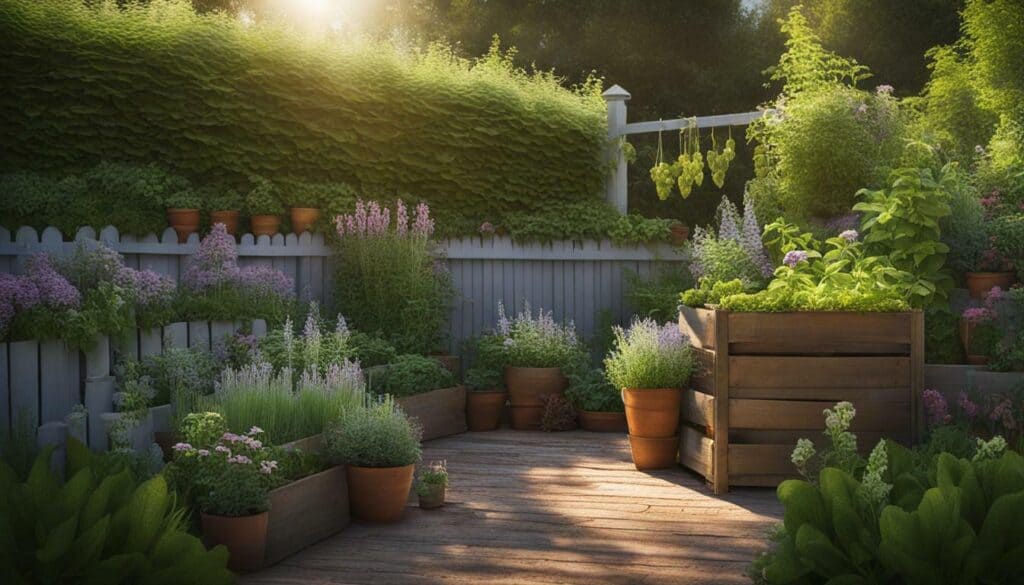
So, why wait? Start cultivating your own herb garden today and experience the joy of growing and using fresh herbs in your cooking.
Using Herbs in Your Culinary Creations
One of the great joys of having an herb garden is being able to use fresh herbs in your culinary creations. Let’s explore some beginner-friendly herbs that will add flavor and aroma to your dishes.

When it comes to cooking with herbs, the possibilities are endless. Here are some popular herbs for beginners:
| Herb | Flavor Profile | Usage |
|---|---|---|
| Basil | Refreshing, sweet, and slightly peppery | Perfect for making pesto, adding to salads, or topping pizzas |
| Parsley | Light, fresh, and slightly bitter | Garnish for soups, stews, and sauces, or use in tabbouleh and chimichurri |
| Thyme | Warm, earthy, and slightly minty | Great for seasoning roasted vegetables, poultry, and fish |
| Oregano | Robust, pungent, and slightly bitter | Essential in Italian and Mediterranean dishes like pasta sauces and pizzas |
| Mint | Cool, refreshing, and slightly sweet | Popular in both savory and sweet dishes, such as salads, cocktails, and desserts |
| Rosemary | Strong, aromatic, and pine-like | Ideal for seasoning roasted meats, potatoes, and bread |
These herbs are versatile and easy to incorporate into your favorite recipes. Whether you’re adding a sprinkle of fresh basil to your homemade pasta sauce or infusing your roasted chicken with the flavors of thyme and rosemary, using herbs will elevate your dishes to a whole new level.
“Cooking with herbs is like painting with flavors.” – Unknown
Not only do herbs add depth and complexity to your meals, but they also offer numerous health benefits. Many herbs are rich in antioxidants, vitamins, and minerals, promoting overall well-being.
To make the most of your herb garden, consider drying or preserving your herbs for future use. Simply hang bundles of herbs upside down in a cool, dry place to air dry. Once dried, store them in airtight containers away from direct sunlight.
Quick Tips for Cooking with Herbs:
- Start with a small amount of herbs and adjust to taste.
- Use fresh herbs at the end of cooking to preserve their flavor.
- Experiment with herb combinations to create unique flavor profiles.
- Don’t be afraid to get creative and try new recipes.
Now that you’re equipped with beginner-friendly herbs and some cooking tips, it’s time to unleash your creativity in the kitchen. Explore different cuisines, experiment with flavors, and enjoy the wonderful world of cooking with herbs!
Sourcing Herb Plants
Now that you know which herb plants you want to grow, it’s time to find the best sources for obtaining them. Let’s explore different options for sourcing your herb plants, whether you prefer buying them from a local nursery or starting from seeds.
Local Nursery
A local nursery is a great place to find a wide variety of herb plants. The advantage of buying from a local nursery is that you can get expert advice from the growers themselves. They can provide information on how they grew the plants and offer recommendations for growing them at home. Additionally, by supporting your local nursery, you are contributing to the local economy and ensuring the availability of fresh, locally grown herbs.
Online Seed Suppliers
If you prefer to start your herb garden from seeds, there are many online seed suppliers that offer a wide selection of herb seeds. It’s important to choose a reputable source that provides organic, non-GMO seeds. Some popular online seed suppliers include Baker Creek, Botanical Interests, Southern Exposure, and High Mowing. When buying seeds, remember that just one packet of each variety is plenty to fill your herb garden with an abundance of fresh herbs.
Local Farmers’ Markets
Another great option for sourcing herb plants is your local farmers’ market. Many small-scale growers sell their herb plants at farmers’ markets, offering a diverse range of varieties and ensuring the freshness and quality of the plants. Buying from local farmers’ markets not only supports local agriculture but also allows you to connect directly with the growers and learn more about their cultivation practices.
Community Gardens and Gardening Groups
Community gardens and gardening groups can also be a valuable resource for sourcing herb plants. These communal spaces often have a shared supply of herb plants that members can use and propagate. By joining a community garden or gardening group, you can access a variety of herb plants and learn from experienced gardeners in your area.
Swapping with Friends and Neighbors
If you have friends or neighbors who are also interested in gardening, consider swapping herb plants with them. This can be a fun and cost-effective way to expand your herb collection. You can exchange cuttings or divisions of established plants, allowing both parties to diversify their herb gardens without spending extra money.
Remember, whether you choose to buy herb plants from a local nursery, start from seeds, or explore other options, it’s important to consider the quality and freshness of the plants. By selecting healthy and well-cared-for herb plants, you’re setting yourself up for a successful and thriving herb garden.
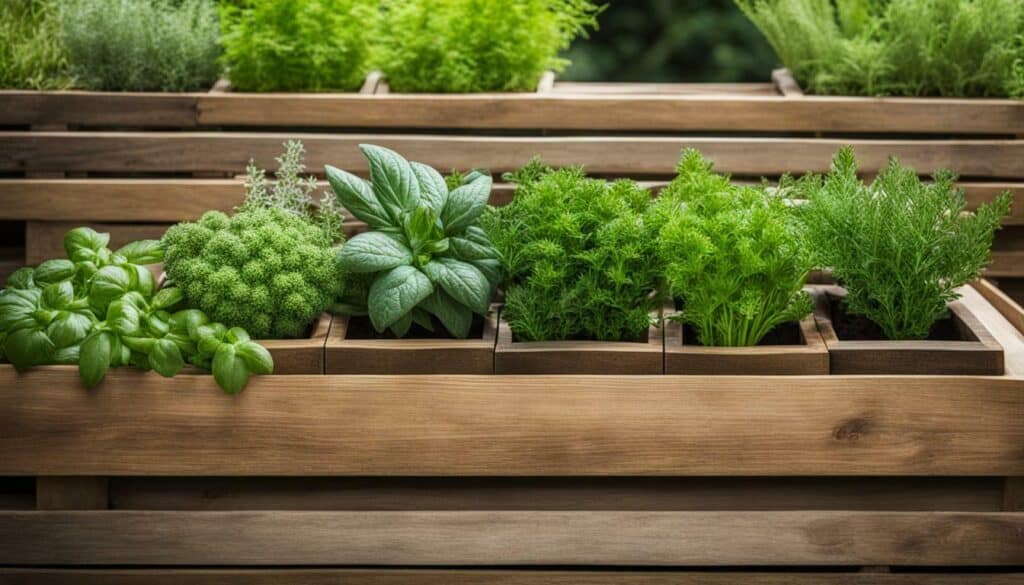
Growing from Seeds vs. Buying Established Plants
When starting an herb garden, you have the option to either grow your herbs from seeds or buy established plants. Let’s weigh the advantages and disadvantages of each approach to help you make an informed decision.
Growing from Seeds
Growing herbs from seeds can be a rewarding and cost-effective option for beginners. Here are some advantages:
- Wide variety: When you grow from seeds, you have access to a wide range of herb varieties that may not be available as established plants.
- Cost-effective: Seeds are generally more affordable than buying established plants, allowing you to grow a larger quantity of herbs within your budget.
- Control over growth: By starting from seeds, you have more control over the entire growth process, from germination to harvesting, giving you a deeper understanding of your plants.
- Learning experience: Growing from seeds provides a valuable learning experience, allowing you to develop your gardening skills and gain confidence in nurturing your herb garden.
However, there are a few disadvantages to consider when growing from seeds:
- Time and patience: Growing from seeds requires time and patience, as it takes longer for the herbs to reach maturity and be ready for harvest compared to buying established plants.
- Less immediate results: It may take some time for your seedlings to sprout and establish themselves, delaying the gratification of seeing a fully grown herb garden.
- Greater risk: Starting from seeds can be more challenging for beginners, as they require careful attention to factors such as temperature, moisture, and lighting to ensure successful germination.
Buying Established Plants
Buying established herb plants offers its own set of advantages and considerations:
- Immediate gratification: By purchasing established plants, you can enjoy an instant herb garden, skipping the initial germination and early growth stages.
- Less care needed: Established plants are more resilient and often require less maintenance compared to seedlings, making them a convenient option for beginners with limited time or gardening experience.
- Guaranteed success: When buying established plants from reputable nurseries or growers, you can be more confident in the quality and health of the herbs, reducing the risk of potential failures.
However, there are a few downsides to consider when buying established plants:
- Higher cost: Buying established plants can be more expensive than starting from seeds, particularly if you need a larger quantity of plants for your herb garden.
- Limited variety: Your options may be limited when buying established plants, as nurseries may not have as wide a selection compared to seeds.
- Potential for transplant shock: When transferring established plants to your garden, there is a risk of transplant shock, which can temporarily stunt growth or even cause the plant to die if not properly cared for during the transition.
Ultimately, the choice between growing from seeds or buying established plants depends on your personal preferences, gardening goals, and available resources. Some gardeners enjoy the process of starting from seeds and the satisfaction of seeing their plants grow from the very beginning, while others prefer the convenience and immediate results of buying established plants. Whichever route you choose, starting an herb garden is a rewarding endeavor that will provide you with a bountiful supply of fresh herbs for culinary creations.

Essential Tips for Herb Garden Care
To ensure the success of your herb garden, it’s important to provide proper care and attention to your herb plants. Here are some essential tips to keep in mind for maintaining a vibrant and productive herb garden.
- Location: Choose a sunny spot for your herb garden, as most herbs thrive in full sun. Make sure the location receives at least 4 hours of sunlight per day.
- Soil: Use well-draining soil for your herb plants. You can opt for a good organic potting mix or prepare your own soil with compost. Avoid compacted or sandy soil, as herbs prefer loamy soil that retains moisture without becoming waterlogged.
- Watering: Water your herb garden regularly, keeping the soil consistently moist but not waterlogged. Most herbs prefer moderate watering, so monitor the soil moisture and adjust accordingly. In hot weather, increase the frequency of watering to prevent the soil from drying out.
- Fertilization: While herbs don’t require heavy fertilization, a balanced organic fertilizer can help promote healthy growth. Apply fertilizer sparingly, following the manufacturer’s instructions. Avoid over-fertilizing, as it can lead to excessive foliage growth with reduced flavor.
- Pruning: Regular pruning is essential to maintain the shape and vigor of your herb plants. Remove any dead or yellowing leaves, and trim back overgrown branches to encourage bushier growth. Pruning also helps prevent herbs from flowering too early, as this can affect their flavor.
- Weeding: Keep your herb garden free from weeds, as they can compete for nutrients and water. Regularly check for weeds and remove them by hand or using a garden tool. Mulching the soil around your herbs can help suppress weed growth and retain moisture.
- Pests and Diseases: Monitor your herb plants for any signs of pests or diseases. Common herb pests include aphids, spider mites, and whiteflies. If infestation occurs, try using organic pest control methods such as insecticidal soap or neem oil. Also, be vigilant about any signs of fungal diseases, such as powdery mildew, and take appropriate measures to prevent or treat them.
- Harvesting: Harvest your herbs regularly to encourage new growth and ensure the best flavor. Harvest in the morning when the essential oils in the leaves are most concentrated. Use sharp pruning shears or scissors to cut the stems above a leaf node. Avoid removing more than one-third of the plant’s growth at a time to maintain its health.
Additional Tips for Herb Garden Care
In addition to the essential tips above, here are some additional tips to enhance the care of your herb garden:
- Companion Planting: Consider planting herbs alongside compatible companion plants to enhance their growth and repel pests. For example, planting basil near tomatoes can improve tomato flavor and deter pests like whiteflies.
- Cutting and Pruning: Regularly cutting and pruning your herbs not only encourages new growth but also provides you with fresh herbs for culinary use. Don’t be afraid to experiment with different cutting techniques and propagation methods, such as rooting herb cuttings in water or soil.
- Overwintering: Some herbs, like rosemary and thyme, can be overwintered indoors if you live in a colder climate. Before the first frost, carefully dig up the herb plants and transfer them to pots or containers. Place them in a sunny location indoors and continue to care for them throughout the winter.
By following these essential tips and additional care recommendations, you can ensure the health and productivity of your herb garden. Enjoy the abundance of fresh herbs and the flavorful culinary creations they inspire!
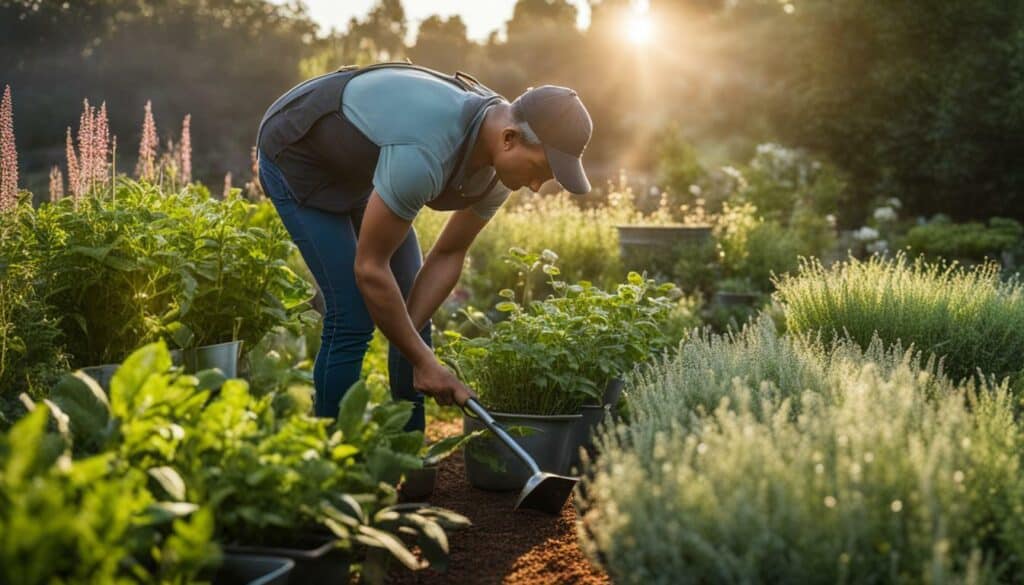
“Regular pruning is essential to maintain the shape and vigor of your herb plants.”
The joy of having an herb garden is being able to harvest and enjoy your own fresh herbs. Let’s explore the best practices for harvesting your herbs and preserving them to savor their flavors even when they’re out of season.
Harvesting your herbs at the right time is crucial for maximizing their flavor and potency. Here are some tips for harvesting and preserving your herbs:
- Timing is key: Harvest your herbs in the morning after the dew has dried but before the sun gets too hot. This is when the essential oils are at their peak concentration, resulting in maximum flavor.
- Use sharp tools: Use clean and sharp scissors or pruning shears to cut the herb stems. This helps to minimize damage to the plant and ensures a clean cut.
- Select mature leaves: Choose mature leaves that are vibrant and fully developed. Avoid harvesting immature leaves as they may not have developed their full flavor yet.
- Trim from the top: When harvesting leafy herbs like basil or parsley, start by trimming from the top of the plant. This encourages bushier growth and prevents the plant from becoming leggy.
- Pinch or cut: For herbs like thyme or oregano, pinch or cut the stems just above a leaf node or branching point. This stimulates new growth and keeps the plant compact.
- Remove flowers: If your herbs start to flower, it’s best to remove the flowers promptly. This directs the plant’s energy back into leaf production and prolongs its overall lifespan.
- Wash and dry: After harvesting, gently wash the herbs to remove any dirt or debris. Pat them dry using a paper towel or salad spinner to prevent them from becoming moldy.
Preserving your fresh herbs allows you to enjoy their flavors long after the growing season has ended. Here are some methods for preserving your herbs:
- Drying: Hang bunches of herbs upside down in a warm, well-ventilated area until they are completely dry. Alternatively, use a dehydrator or oven on low heat to speed up the drying process. Once dried, store the herbs in airtight containers away from sunlight.
- Freezing: Chop your herbs finely and place them in ice cube trays. Fill each compartment with water or olive oil and freeze. Once frozen, transfer the herb cubes into a freezer bag or container. These can be easily added to soups, stews, or sautés for instant flavor.
- Infusing: Create herb-infused oils or vinegars by adding fresh herbs to a bottle of oil or vinegar. Let it steep for a few weeks in a cool, dark place to infuse the flavors. Strain out the herbs and use the infused oil or vinegar in dressings, marinades, or as a finishing touch.
- Pesto: Blend fresh herbs, garlic, nuts, cheese, and olive oil to create a flavorful pesto sauce. Spoon the pesto into ice cube trays and freeze. Once frozen, transfer the pesto cubes into a freezer bag or container. Thaw and use as needed.
By harvesting and preserving your herbs, you can continue to enjoy their flavors throughout the year. Whether you dry them, freeze them, or create infused oils and sauces, these methods will help you make the most of your herb garden.

“The best time to plant herbs is in the spring when the soil has warmed up and all danger of frost has passed.”
Remember, the key to successful herb harvesting and preservation is to choose the right timing, handle the herbs with care, and utilize suitable methods for preserving their flavors. With these practices, you can enjoy the taste of fresh herbs in your culinary creations all year round.
Herb-Infused Recipes
Now that you have a thriving herb garden, it’s time to put those flavorful herbs to good use in delicious herb-infused recipes that will elevate your culinary creations. Get ready to tantalize your taste buds!
Using fresh herbs in your cooking adds a burst of flavor and aromatic delight to any dish. Whether you’re a seasoned chef or a beginner in the kitchen, these herb-infused recipes are simple to follow and guaranteed to impress.
1. Lemon Rosemary Roasted Chicken
This classic roasted chicken recipe is elevated with the addition of fresh rosemary and zesty lemon. The combination of these herbs creates a fragrant and flavorful dish that is perfect for a hearty family dinner or a special occasion.
Ingredients:
- 1 whole chicken
- 2-3 sprigs of fresh rosemary
- 1 lemon, sliced
- Salt and pepper to taste
Instructions:
- Preheat the oven to 375°F (190°C).
- Place the whole chicken in a roasting pan and season generously with salt and pepper.
- Stuff the cavity of the chicken with fresh rosemary and lemon slices.
- Roast the chicken in the preheated oven for about 1 hour and 30 minutes, or until the internal temperature reaches 165°F (74°C).
- Remove from the oven and let it rest for 10 minutes before carving.
- Serve with roasted vegetables and enjoy!
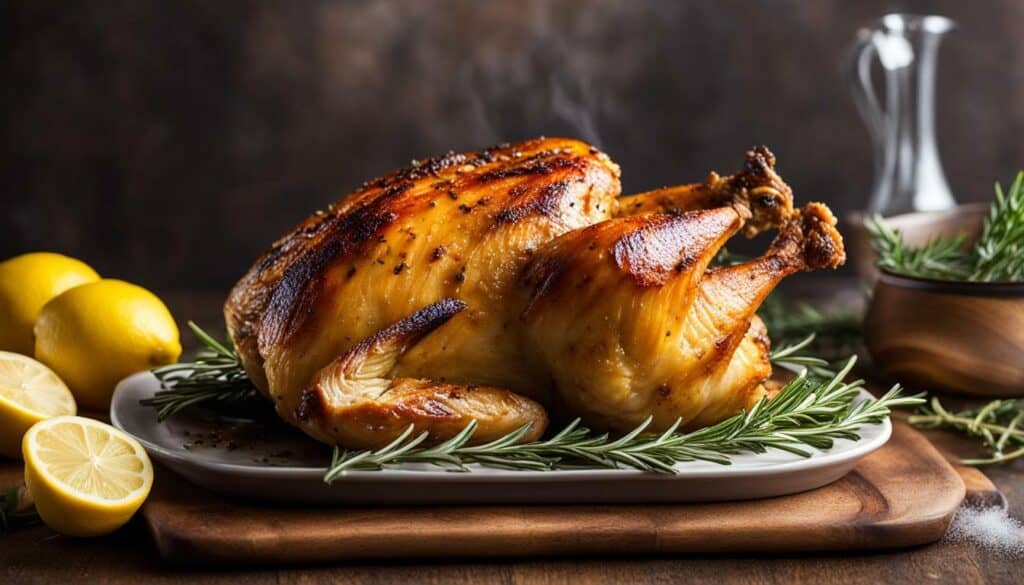
2. Basil Pesto Pasta
This classic Italian dish is made with fresh basil leaves, garlic, pine nuts, Parmesan cheese, and olive oil. The vibrant green color and aromatic flavors of the basil make this pesto pasta a crowd-pleaser.
Ingredients:
- 2 cups fresh basil leaves
- 3 cloves of garlic
- 1/4 cup pine nuts
- 1/2 cup grated Parmesan cheese
- 1/2 cup extra virgin olive oil
- Salt and pepper to taste
- 1 pound pasta of your choice
Instructions:
- In a food processor, combine the basil leaves, garlic, pine nuts, and Parmesan cheese. Pulse until coarsely chopped.
- Slowly drizzle in the olive oil while the food processor is running until a smooth paste forms.
- Season with salt and pepper to taste.
- Cook the pasta according to package instructions until al dente. Drain.
- In a large bowl, toss the cooked pasta with the basil pesto until well coated.
- Serve immediately and garnish with additional Parmesan cheese if desired.
3. Mint Infused Iced Tea
Cool down on a hot summer day with refreshing mint-infused iced tea. This thirst-quenching beverage is made by steeping fresh mint leaves in hot water and then chilling it with ice. It’s the perfect way to enjoy the natural sweetness and refreshing taste of mint.
Ingredients:
- 4 cups water
- 4-6 sprigs of fresh mint
- 4 tea bags
- 2 tablespoons honey (optional)
- Lemon slices for garnish
Instructions:
- In a saucepan, bring the water to a boil.
- Add the fresh mint leaves and tea bags to the boiling water.
- Remove from heat and let it steep for 5-7 minutes.
- Strain the tea into a pitcher and discard the mint leaves and tea bags.
- Add honey to sweeten, if desired.
- Refrigerate until chilled.
- Serve over ice with lemon slices for garnish.

“Using fresh herbs in your recipes adds an incredible depth of flavor that you can’t achieve with dried herbs. Don’t be afraid to experiment and get creative in the kitchen!”
These herb-infused recipes are just the beginning of the culinary possibilities that fresh herbs offer. From soups and salads to marinades and desserts, the options are endless. So, grab a handful of your favorite herbs from your garden and let your taste buds guide you on a culinary adventure!
Growing Herbs Indoors
Don’t let limited space or harsh weather conditions stop you from enjoying the benefits of a herb garden. Discover the joys of growing herbs indoors and learn which herbs thrive in an indoor environment.
Growing herbs indoors is a convenient and accessible way to have fresh herbs at your fingertips year-round. Whether you live in an apartment with limited outdoor space or in a climate that’s not favorable for herb gardening, bringing your herbs indoors allows you to cultivate a thriving herb garden regardless of the conditions outside.

So, which herbs are best suited for indoor cultivation? Here are some of the top herbs that thrive in an indoor environment:
| Herb | Description |
|---|---|
| Basil | Basil is a versatile herb that adds a fresh and aromatic flavor to a wide range of dishes. It requires ample sunlight and well-draining soil. Place your basil plant near a sunny window or use grow lights to provide sufficient light for its growth. |
| Chives | Chives are a hardy herb that can thrive in indoor conditions. They require moderate sunlight and well-drained soil. Trimming the leaves regularly will encourage fresh growth and prevent the plants from becoming leggy. |
| Mint | Mint is a fast-growing herb that is well-suited for indoor cultivation. However, due to its vigorous growth habit, it is best grown in a separate container to prevent it from taking over other herbs. Mint thrives in moist soil and bright, indirect sunlight. |
| Parsley | Parsley is a biennial herb that can be grown indoors year-round. It requires moderate sunlight and well-draining soil. Keep the soil consistently moist and trim the leaves regularly to promote bushier growth. |
| Rosemary | Rosemary is a woody herb that can be successfully grown indoors. It prefers a sunny window or a spot with bright, indirect light. Rosemary requires well-draining soil, and it’s important to allow the soil to dry out slightly between waterings. |
In addition to these herbs, other popular options for indoor herb gardening include thyme, oregano, and sage. These herbs can be grown in containers and placed near a sunny window or under grow lights to ensure they receive adequate light for their growth.
When growing herbs indoors, it’s important to provide the right conditions for their success. Here are some essential tips for indoor herb garden care:
- Choose the right containers with good drainage to prevent waterlogging and root rot.
- Use a well-draining potting mix specifically formulated for indoor plants.
- Place your herbs in a location that receives at least 4-6 hours of sunlight per day, either from a sunny window or grow lights.
- Water your herbs when the top inch of soil feels dry, but avoid overwatering to prevent root rot.
- Rotate your herb pots every few days to ensure even growth and prevent leaning towards the light source.
- Fertilize your herbs regularly with a balanced liquid fertilizer formulated for indoor plants. Follow the instructions on the fertilizer packaging for the correct dosage.
“Growing herbs indoors allows you to enjoy fresh flavors and aromatic scents throughout the year, regardless of the outdoor conditions.”
With a little bit of care and attention, you can create a thriving indoor herb garden that will provide you with a constant supply of fresh herbs for your culinary creations. Not only will you have the convenience of having your favorite herbs at your fingertips, but you’ll also add beauty and greenery to your indoor space.
Whether you’re a seasoned gardener or a beginner, growing herbs indoors is a rewarding and enjoyable experience. So, don’t let limited space or unfavorable weather hold you back from starting your own indoor herb garden. Get started today and discover the joys of growing herbs indoors.
Conclusion
Starting a basic herb garden is a rewarding and accessible endeavor that allows you to have fresh, aromatic herbs at your fingertips. With the right plants, care, and guidance, you can embark on a journey of growing your own herb garden, even as a beginner.
By choosing beginner-friendly herb plants and following the proper cultivation and care techniques, you can create a thriving herb garden that enhances your culinary creations. Whether you have a large outdoor space or a small indoor area, there are options for everyone to enjoy the benefits of growing herbs.
When it comes to sourcing herb plants, it’s important to consider the quality and origin of the plants. While buying from big box hardware stores may not always be recommended, local nurseries and reputable seed suppliers offer a wide range of organic, non-GMO options. Be sure to inquire about the growing methods and recommendations when purchasing herb plants.
Deciding between growing from seeds or buying established plants is a personal choice that depends on factors such as time, space, and preference. Both methods have their advantages and disadvantages, so it’s worth considering your specific needs and circumstances before making a decision.
Proper care is essential for maintaining a healthy herb garden. Regular watering, suitable sunlight, and well-drained soil are key factors to consider. Additionally, harvesting your herbs at the right time and implementing preservation techniques can ensure a continuous supply of fresh herbs for your culinary endeavors.
The versatility of herbs extends beyond cooking. They can also be used in herb-infused recipes, adding a burst of flavor and aroma to your dishes. Experimenting with different combinations of herbs can elevate your culinary creations to new levels.
For those with limited outdoor space or unfavorable growing conditions, growing herbs indoors is a viable option. Certain herbs, such as basil, mint, and thyme, thrive in indoor environments and can be easily incorporated into your home decor.
In conclusion, starting a basic herb garden is a fantastic way to enhance your cooking, embrace nature, and embark on a fulfilling journey of growing your own herbs. With a beginner-friendly selection of herb plants, proper care, and a dash of creativity, you can enjoy the flavors and benefits of fresh herbs right from your own garden.
FAQ
Q: Where can I buy herb plants for my herb garden?
A: You can buy herb plants from local nurseries, growers, or even propagate them from cuttings from a neighbor or friend. It’s best to ask about their growing methods and if they used any synthetic fertilizers.
Q: Can I grow herbs from seeds?
A: Yes, many herbs can be started from seed in your garden. Some popular herbs to start from seed include cilantro, parsley, dill, and basil. Make sure to buy organic, non-GMO seeds from reputable sources.
Q: How do I take care of my herb garden?
A: Herbs need well-drained soil, regular watering, and ample sunlight. Water them during the cooler hours of the morning and make sure they receive at least 4 hours of full sun per day. Avoid over-fertilizing and harvest herb plants right before they start flowering for the best flavor.
Q: What are some easy herbs to grow for beginners?
A: Basil, thyme, oregano, parsley, mint, rosemary, sage, chives, and dill are all great herbs for beginners. They are easy to grow and require minimal maintenance.
Q: How do I harvest and preserve fresh herbs?
A: It’s best to harvest herb plants right before they start flowering. Cut the herbs close to the leaf intersection to ensure quick regrowth. To preserve fresh herbs, you can dry them by hanging them upside down or use them immediately in your cooking.
Q: Can I grow herbs indoors?
A: Yes, many herbs can be grown indoors. Some of the best herbs to grow indoors include basil, rosemary, thyme, and mint. Make sure they receive enough sunlight and water them regularly.
What Are Some Easy Tips for Starting a Medicinal herb Garden?
Creating a successful medicinal herb garden can be achievable with these basic medicinal herb garden tips. Begin by selecting the right location with adequate sunlight and well-drained soil. Research the herbs you want to grow, considering their requirements for watering, spacing, and care. Start with a few herbs that are easier to cultivate before expanding your garden. Regularly harvest the herbs to encourage continuous growth and maximize their healing properties.

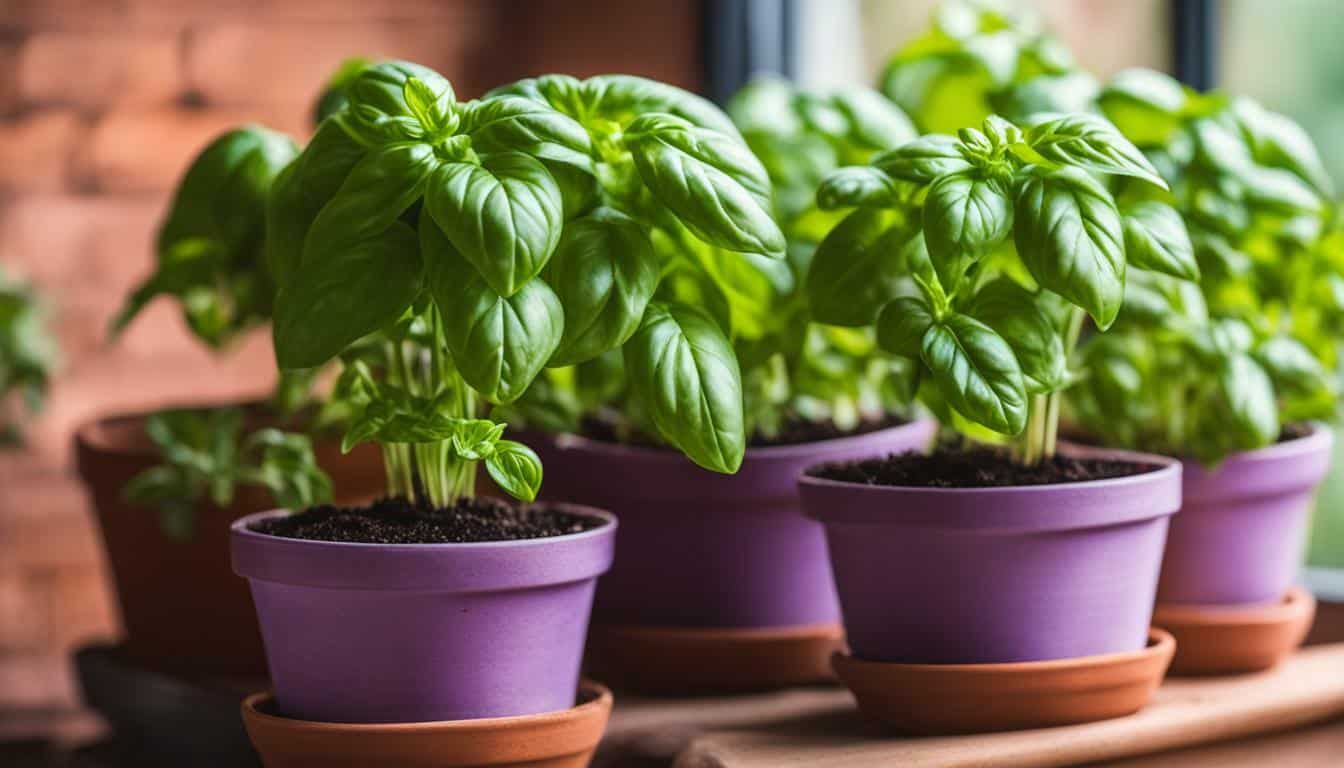



Leave a Reply